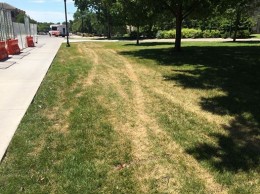(Megan Kennelly, KSU Plant Pathology)
When droughty, wilting turf is subject to traffic from vehicles, mowers, or even feet, it can develop tracks. If possible, when turf is wilty, avoid traffic altogether. If you must apply traffic, try to do it during cooler parts of the day. Sites with underlying problems like compaction are more prone to drought and therefore more sensitive to traffic.
The KSU Turf Team has several projects related to drought, management, and traffic. Want to learn more? Come out to the Turf Field Day! In addition, stay tuned to this blog for future research updates with specific results from our trials.
We continue to see samples coming into the diagnostic lab with poor root health, but no pathogens. We got a ton of rain in May, and those root systems declined from too much water. Now that we are into the summer heat, the plants can’t thrive on those compromised root systems. Take note of problem areas, and over time you can try to alleviate compaction, change traffic flows, reduce drainage issues, etc. As much as possible, make the site function at its best to support the plants. You don’t want the site to make things more challenging than it needs to be.

